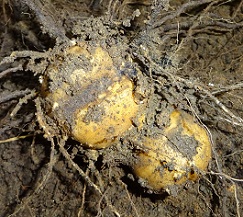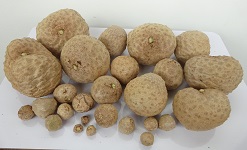| Home | Nature Weekly Index |
4 September 2016 | Air Potato Tuber | Dioscorea bulbifera |
Last week, the Air Potato Vine (Dioscorea bulbifera) that started its journey in May 2015 finally come to an end. All the leaves and even the growing tip had started to turn brown about a week back. Actually, I should say the death was only temporary. If I were to leave the empty pot alone, the vine will eventually re-generate again because of the hidden tuber underground. In fact, this was the second life cycle of this vine. This time round I had decided to dig out the tuber to have a closer look.

 The underground tuber was the part of this vine that I had always wanted to see. Furthermore, it was about time to change
the crop in that pot. Armed with a hand trowel, I started to dig and expecting to see a large tuber since the vine had been
producing many large bulbils. To my surprise, there were only 2 mid-size tuber though root system was rather extensive.
The length was about 8 centimetres (cm) and a width of about 3 cm.
The underground tuber was the part of this vine that I had always wanted to see. Furthermore, it was about time to change
the crop in that pot. Armed with a hand trowel, I started to dig and expecting to see a large tuber since the vine had been
producing many large bulbils. To my surprise, there were only 2 mid-size tuber though root system was rather extensive.
The length was about 8 centimetres (cm) and a width of about 3 cm.
 As shared in June, a prominent feature of this vine is the numerous bulbils at
the leaf axils along the twining stem. In total, 26 bulbils of different sizes were harvested from the stem. I had left
them in a container for the time being but would not be able to keep them for too long as they would start germinating even
without placing them on soil. It is unlikely that I will grow them again soon.
As shared in June, a prominent feature of this vine is the numerous bulbils at
the leaf axils along the twining stem. In total, 26 bulbils of different sizes were harvested from the stem. I had left
them in a container for the time being but would not be able to keep them for too long as they would start germinating even
without placing them on soil. It is unlikely that I will grow them again soon.
.jpg) There appeared to be two types of air potato bulbils in term of its colour, one is dark coffee coloured and another is light
brown. The one in my pot was the light brown version. I had seen the darker coloured version being cultivated but not in
the wild.
There appeared to be two types of air potato bulbils in term of its colour, one is dark coffee coloured and another is light
brown. The one in my pot was the light brown version. I had seen the darker coloured version being cultivated but not in
the wild.
Though the Air Potato Vine is classified as one of the most invasive plant species in Florida (USA) since 1993 due to its invasive nature, it is not so much a problem here since we had other climbers that exert more damaging effect on other plants compared to the Air Potato Vine. The number one contender is the Sarsaparilla Vine (Smilax setosa). It can be considered as the giant of the climbers here with its thick stem, strong tendrils and large leaves. Typically, it wraps round other trees while it made its climb, suffocating the smaller ones by devoid them of sunlight and add its heavy weight on mid-size tree that caused them to topple under strong wind. Getting rid of Sarsaparilla Vine is much more difficult compared to Air Potato Vine because of its thick and thorny stem. It has been described in the Singapore Biodiversity Encyclopedia (page 460) as a native invasive species that overgrowing forest edges and delaying regeneration of forest in open areas.